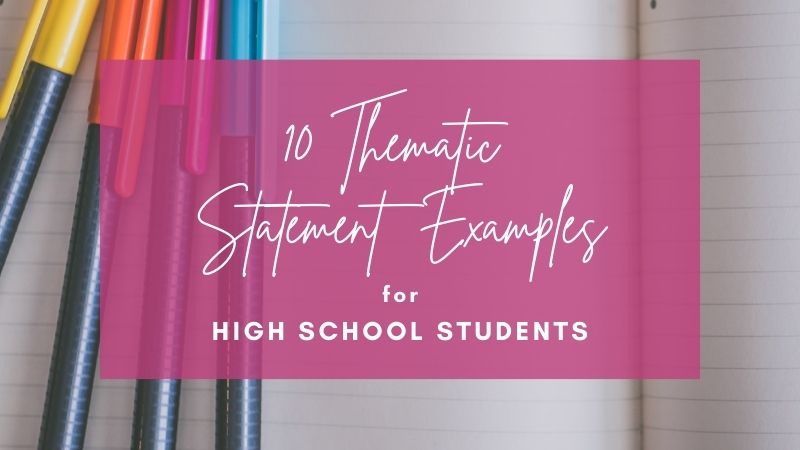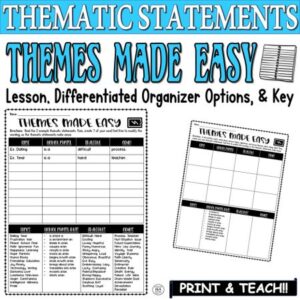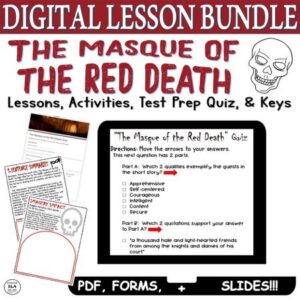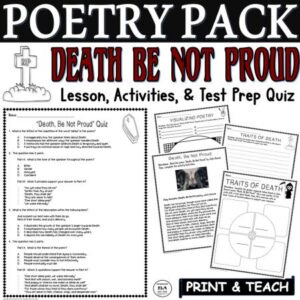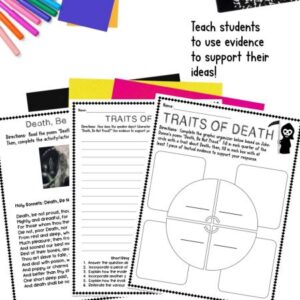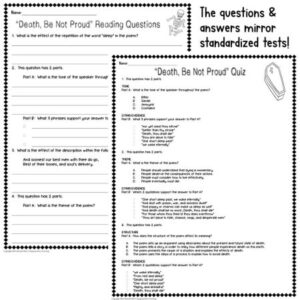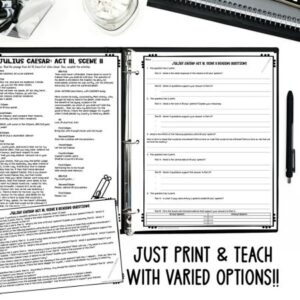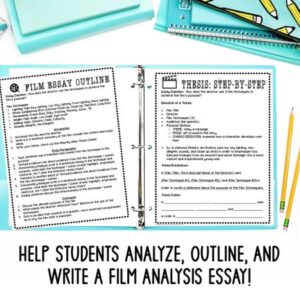Think of the last book you read… what was it about? When you go to answer this question, do you focus on a summary of the plot or do you boil it down to a statement that focuses on the overall message of the book? The answer to that question may depend on whether you’re an English teacher or not! If you’re doing the latter for the many books you read, which most often I think we – English teachers – unconsciously do, then you’re sharing thematic statement examples.
You are providing an overarching idea of what that book is about without providing many details about what happens with the plot and characters. But this is a skill that’s learned and honed; it’s a skill that you, as an English teacher, were taught when you were a student and now likely teach your own students!
And teaching theme and how to write thematic statement examples is important. Not just because it’s a great way to provide an overview of a book during small talk, but because it provides a clear way to check reading comprehension and understanding, it is a way to work on a different facet of summarizing, and it guides students to more analysis of the overall text.
Need help with Test Prep? Check out this FREE Pack of 3 Test Prep Activities to help students achieve success on standardized tests!
How To Teach With Thematic Statement Examples
What is theme?
Theme in general is the deeper meaning of a story. It is often a recurring central idea that leads to a take-away message for the reader. Different parts of a story contribute to that message and different texts may share a theme, but how they’re communicated could be very different.
What is a thematic statement and what are the elements of thematic statement examples?
A thematic statement is an overall message from the story in the form of a short sentence. Some might boil it down to the big idea of a particular text, whether that’s a poem, short story, or novel.
What’s noteworthy is that a theme – and thus a thematic statement – is not always singular in a text. There could be multiple themes in a piece of literature. Students could look at characters, setting, and plot, in addition to conflict and resolution in any given story. Through all of these elements, different themes might emerge though they are usually closely related.
To teach students how to write strong thematic statements, a formula is helpful: Topic + Message = Thematic Statement. With this, students can use textual evidence to ground their thematic statements.
To help your students really ‘get’ the idea of theme check out this fun activity with graphic organizers to create different thematic statements.
Want to teach your students how to write a LITERARY ANALYSIS essay? Check out >>> Use Literary Analysis Examples in 5 STEPS!
10 Thematic Statement Examples
Whether you’re teaching short stories, poetry, drama, or film, here are 10 thematic statement examples to use with your students:
3 Short Story Examples
- “The Lottery” by Shirley Jackson is the story of a yearly tradition that proves deadly in a small town. The story also provides several options for thematic statements such as a mother’s love develops over time or people should avoid participating in a harmful tradition, or even parents must encourage their children to listen to the law. This bundle of activities for “The Lottery” ensures students’ clear understanding of the story through Common Core-style questions before they dive into determining the theme of the story.
- “The Masque of the Red Death” by Edgar Allan Poe is about Prince Prospero who attempts to avoid a plague by hiding out from the inhabitants of his town. Like most Poe stories, it’s dark and twisted and absolutely perfect for engaging students! The exploration of these themes and the textual evidence to support each one would allow you to differentiate for the students in your classroom. You could provide a variety of theme statements such as “Fear is an important part of human relationships” or “Having a positive attitude eliminates panic.” Students can read the story to find textual evidence for support. These examples and more are included in the activity pack for this amazing Poe story.
- “An Occurrence at Owl Creek Bridge” by Ambrose Bierce is about a civilian during the Civil War who is facing death as a result of his actions. It also has a twist that will capture students’ attention. Students can brainstorm one or two thematic statement examples and then use highlighters to color-code textual evidence. For example, a blue highlighter for evidence of “fantasies can be deceptive” and a green highlighter that supports “bravery will sometimes lead to success.” Once complete, students can review their color-coded stories to see which statement is best supported.
3 Poetry Examples
- “Annabel Lee” by Poe is about the love the narrator has for a woman in his life, however, it’s Poe so it also focuses on death! Before diving into thematic statements make sure students have a strong comprehension of the poem using these poetry activities for this Poe poem. Once they understand the poem, they can shift to writing thematic statement examples about it. What statement is best? What textual evidence would they use?
-
- Death cannot stop a person’s love.
- Beware the jealousy of the angels in heaven.
- Separation causes the heart to yearn for love.
- Love will ultimately cause gloom and despair.
- “Death, Be Not Proud” by John Donne tries to convince the reader to not fear death. To help with any lesson using this sonnet, check out these activities for visualization, comprehension, and writing. Then students can debate which thematic statement example is best:
-
- People should understand that dying is momentary.
- People deserve the consequences of their actions.
- People must consider how to live effectively.
- People eventually must die.
- “A Poison Tree” by William Blake is a short poem about anger and, ultimately, murder. Get students to look closer at the emotional language in this poem with this group of activities to make teaching poetry stress-free. Then, they can shift to writing about any of these thematic statement examples for “A Poison Tree” with confidence! Which would they choose?
-
- Anger that is not dealt will escalate into harmful actions.
- Beware how you treat your enemies and your friends.
- Growing a tree takes time and careful planning.
- People deserve the consequences of their acts.
Need ideas for short stories for applying thematic statement examples? Click below!
2 Play Examples
- A scene from Romeo and Juliet by William Shakespeare that is perfect for analysis of theme is Tybalt’s death and the Prince’s speech in Act 3, Scene 1. These activities are simple yet rigorous to ensure students’ understanding! Through close reading, students can then focus on generating ideas about the theme of this scene. They’ll likely come up with words such as revenge, friendship, and consequences. Use these theme statement development activities with graphic organizers to scaffold the analysis for all students.
- In Act 3, Scene 2 of Julius Caesar, Brutus makes a speech where he attempts to justify his murder of Caesar and Antony responds. Working closely with this scene using these comprehension activities can ensure students’ understanding before they develop a thematic statement for it. In fact, the comprehension activities will help to find textual evidence for any number of thematic statement examples and options.
| Thematic Statement Examples | Textual Evidence |
| Leading an entire country involves sacrifice. | “Nay, that’s certain / We are blest that Rome is rid of him” |
| Friendship requires hard work and dedication. | “O judgment! thou are fled to brutish beasts / And men have lost their reason” |
| People should require evidence before condemning someone. | “The evil that men do lives after them / The good is oft interred with their bones” |
| One must employ rational thinking when assessing a situation. | “My heart is in the coffin there with Caesar / And I must pause till it come back to me” |
| Murder is justifiable if a person has committed horrible crimes. | “You all did love him once, not without cause / What cause withhold you then, to mourn for him?” |
| Citizens have a duty to listen to their politicians in every situation. | “I depart, –that, as I slew my best lover for the / good of Rome, I have the same dagger for myself” |
2 Film Examples
Incorporating film analysis is another option to explore and create thematic statement examples.
Two favorite films to feature in class are the 1990 fantasy-romance film Edward Scissorhands by Tim Burton and Baz Luhrmann’s 1996 Shakespearean adaptation Romeo + Juliet. Before focusing on thematic statement examples, teach a bit about film techniques and analysis with these activities that can be used with any film!
Students can add another layer of analysis with film-focused vocabulary. In Edward Scissorhands, students might notice that after Edward meets Peg the visuals illustrate that some people may never be accepted for who they are. With Romeo + Juliet, the different camera angles and chosen shots strengthen the message that contention between people will ultimately affect others and lead to their destruction.
Why Teach With Thematic Statement Examples?
No matter the text, students often struggle with theme and creating thematic statement examples. Too often, the theme of a particular story, movie, or song is misunderstood. In order to be successful with thematic statements, students need to focus their analysis and find relevant textual evidence. These are skills that students must learn and practice year after year! With these 10 options, you’ll hopefully have lots to choose from as you teach your students!
Once students learn to write accurate and specific thematic statements through using thematic statement examples, you can take the next step by exploring several texts linked by theme. Check out this post that examines particular topics for themed units such as taking revenge or death and dying.
Need more fun lessons and activities that incorporate thematic statement examples? Check out my store Kristin Menke-Integrated ELA Test Prep!

